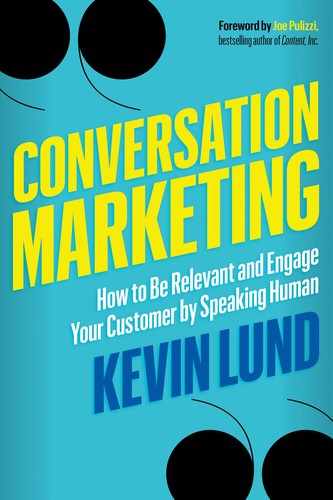APPENDIX B
Putting It All Together
For those of you who want to skip right to it, the following is a master “cheat sheet” of all the major points covered in this book to get you going on having the right kind of conversation in your content marketing strategy. You may already know enough and want to home in on a specific place to learn more. If so, use this list as a tool to help locate the specific chapter addressing your question.
Before the Conversation: Know Your Audience
- Decide how you want to start the conversation. (Chapter 7)
- Listen. Use listening tools (mentioned in Chapter 5) to research keywords and subjects trending in search engines (SEO) to make the robots happy.
- Using the rules of conversation covered in this book, produce useful, memorable, keyword-rich content. (Chapter 1)
- Find your audience's “pain points.” What problems are they experiencing that you can help solve? (Chapter 3, Chapter 7)
- Go where your customers are congregating. Find out where they're gathering online and make sure you're also there. (Chapter 8)
- Hire specialists to write and produce the content relevant to your audience. (Chapter 6)
- Keep tabs on your audience's likes and dislikes in social media. (Introduction)
Start the Conversation: Seven Steps to a Great Piece of Content
- Tie your content to your goal. (For instance, T3's goal was to inspire investors to trade more.) (Introduction)
- Consider whom you're writing for (the personality of your audience, or “persona”). (Chapter 1)
- Keep in mind the Four Cs: clear, clever, concise, consistent. (Chapter 1)
- Answer “the only three questions you'll need to ask.” (Chapter 7)
- Craft a great headline for bots and humans. How will yours stand out? (Chapter 7)
- Join the conversation and remember to be humble. (Chapter 2, Chapter 3)
- Step back and listen. (Chapter 4, Chapter 8)
After the Conversation: Listen to Your Audience
- Remember to “read the room” to make sure you're not talking too much and the audience is still paying attention. (Chapter 9)
- Consider letting others speak who can tell your story from their own perspective. Learn about different types of influencers. (Chapter 9)
- Learn how to “mirror” your audience so they know you can hear them. (Chapter 8)
- Go beyond the screen. Consider hosting meetings or seminars that attract your audience. (Chapter 5, Chapter 8)
- Look for your audience's questions and address them, either with answers or new posts. (Chapter 8)
- Let your customers speak on your behalf. (Chapter 9)
The Power of Patience
- Track quantitative data on your campaign, but don't put too much importance on the initial numbers. (Chapter 8)
- Avoid the “ROI conundrum.” Remember that content marketing doesn't promise immediate payoff in new customers and cash. (Chapter 8)
- Don't expect instant hits. A content marketing campaign takes time. You're building trust with your audience, not selling them a product (at least not at first). (Chapter 8)
- Learn ways to prove you're growing influence, even if it's not measured in sales. (Chapter 9)
- Be relevant. Qualitatively “police” your quantitative findings with a human subject matter expert to determine what is relevant to make your readers happy. (Chapter 6, Chapter 8)
- Be ready to educate your team about the need to step back and wait for ROI. Not everyone will be on board, and your job is to help convince them. (Chapter 8)
- Learn how to build calendars and stick to them. (Chapter 4)
..................Content has been hidden....................
You can't read the all page of ebook, please click here login for view all page.
